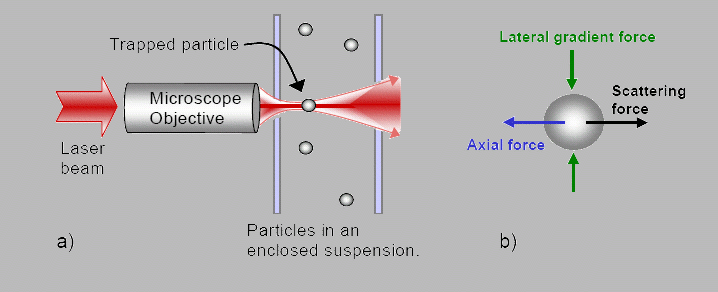 |  |
 |  |

The ability of light to exert an optical radiation pressure onto a particle was first reported by Arthur Ashkin in the 1970‘s. Ashkin observed latex particles, suspended in water; when in the path of a focused laser beam were drawn into the axis of the beam and accelerated in the direction of propagation. At the container wall the particle became trapped. When the laser was turned off the particle diffused away under Brownian motion. Ashkin explained his observations via a ray-optics description of the system [1]. There are many biological [2], colloidal [3], and material [4] applications of optical tweezers.
Photon momentum within a light beam can be transferred to a particle via refraction, reflection or absorption of photons by the particles. The condition for a particle to be optically trapped within a laser beam is when the resulting forces on the particle are sufficient to prevent it from leaving the beam. A dielectric particle of a higher refractive index than its surrounding media can be trapped within a highly focussed TEM00 Gaussian laser beam as illustrated (above). The particle is held on the beam axis by a transverse force resulting from the gradient intensity profile of a Gaussian beam. The axial force, arising from the high convergence of the beam, enables the particle to be trapped in three dimensions by overcoming the scattering force acting in the direction of beam propagation.
[1] Ashkin, A.
"Acceleration and Trapping of Particles by Radiation Pressure"
Physical Review Letters 24 (1970) p.156
[2] Wang M. D., Yin H., Landick R., Gelles J. and Block S. M.
"Stretching DNA with Optical Tweezers"
Biophysical Journal 72 (1997) p.1335
[3] Grier D.
"Optical tweezers in colloid and interface science"
Current Opinion in Colloid & Interface Science 2 (1997) p.264
[4] Gauthier R. C., Tait N., Mende H. and Pawlowicz C.
Applied Optics 40 (6) (2001) p.930